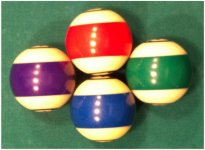Since I have never seen object ball swerve, or at least never recognized it, I made the same assumption as PJ: the above is a typo. If not, I still have an offer open of $200 to anyone who can show me how to make an object ball curve significantly with a legal shot. (The details are posted elsewhere.)
I feel your $200 is safe.
However,I think I can make an object ball curve,by driving it into another ball.
Lotta draw,higher than medium speed,fullish contact on second object
ball.I've used it to curve around an intervening ball and into a pocket.
Same effect but to a lesser degree as making an in-off
